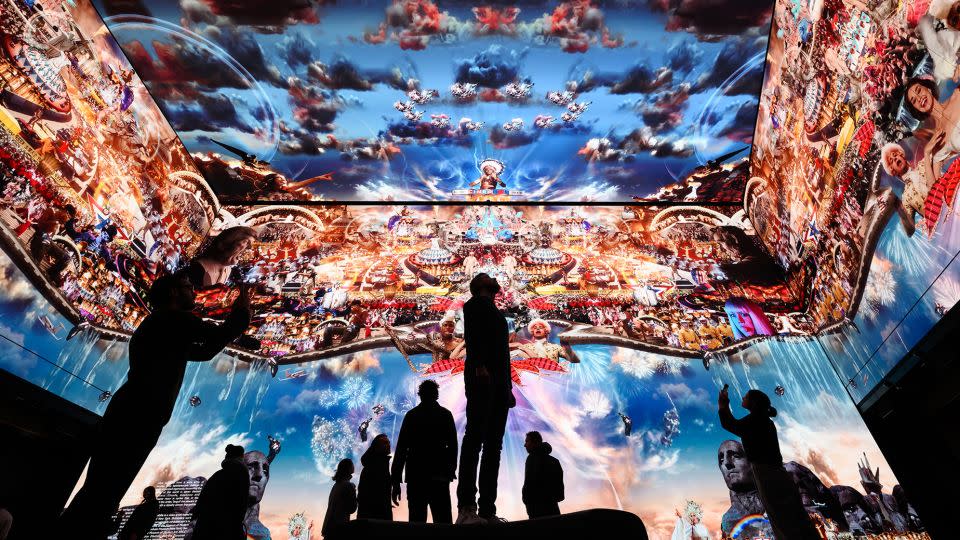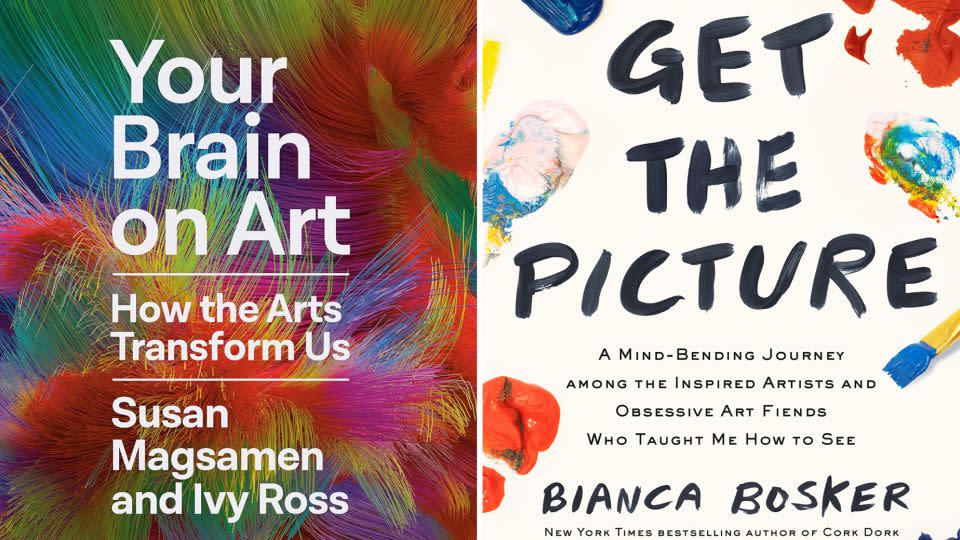Shift Your Mindset is a monthly series from CNN’s Mindfulness, But Better team. We talk to experts about how to do things differently to live a better life.
Most people don’t pick up a coloring book, paintbrush, poetry collection or museum membership for the health benefits — but maybe it’s time to start.
Research shows that art experiences, whether as a maker or a beholder, transform our biology by rewiring our brains and triggering the release of neurochemicals, hormones and endorphins.
In response to a growing body of evidence that art can radically improve both physical and mental health in effective and measurable ways, more health care practitioners are prescribing arts engagement as part of treating a wide array of conditions, including: obesity, heart disease, chronic pain, dementia, Parkinson’s disease, loneliness and depression.
The power of diverse arts practices to promote healing, well-being and even longevity provides benefits that rank right up there with exercise, nutrition and sleep, argued Susan Magsamen in her bestseller, “Your Brain on Art: How the Arts Transform Us,” coauthored with Ivy Ross.
Could this be why the arts have evolved over millennia to become central to human experience?
“I always thought of art as a luxury,” conceded Bianca Bosker in her new book, “Get the Picture: A Mind-Bending Journey among the Inspired Artists and Obsessive Art Fiends Who Taught Me How to See.” “It can’t feed you, house you or be used to kill predators.”
But she discovered that many scientists consider art a basic human need.
“Art is one of our oldest creations (humans invented paint long before the wheel), one of the earliest means of communication (we drew long, long, long, long before we could write), and one of our most universal urges,” she wrote.
Both Bosker and Magsamen recommend that everyone make art a daily practice, based on evidence and experience. Here’s why they see art as anything but a luxury.
This conversation has been edited and condensed for clarity.

CNN: You both argue that art is fundamental to human existence. How do you explain that to skeptics?
Susan Magsamen: We are literally physiologically wired for the arts. Input from our senses builds connections among our brains’ 86 billion neurons. Engaging with art, whether as a spectator or creator, actually brings information into our bodies and profoundly impacts our biological circuitry.
Art’s simultaneous activation of multiple neurological and physiological systems — a unique evolutionary phenomenon — involves the entire brain, body and spirit. The next time you feel moved by your favorite song, consider that an artist’s choices are changing you on a cellular level.
Bianca Bosker: Many experts agree that art is both an innate human impulse and a biological predisposition that has helped our species survive. It’s only a modern-day misconception that looking at art is purely philosophical or intellectual. At its core, art is a physical experience — and that applies not only to music — with its thrumming bass that you can feel — but also to painting and visual arts as well.
For the past 100 years or so, society has focused on the ideas behind artwork — that the thought trumps the thing. But when you watch artists making art, it is a physical experience. It’s practically athletic.
Engaging with artwork in person, as two bodies in space, is crucial. Researchshows that factors like an artwork’s size, or how we move around it, can change how we value art. You can think about connecting with art the way you do with people. Just as a virtual meeting with someone is different from sitting across the dinner table, it’s very different to look at a tiny image of an artwork on Instagram than it is to be body to body with, for example, a huge Mark Rothkopainting.
There’s fascinating anecdotal evidence of how artworks can act on people at a physical level. The term “Stendhal syndrome” describes people going to pieces — struck with dizziness, nausea, exhaustion, fainting spells or crying — in front of pieces of art. Stories like how a woman in a museum in Houston stripped naked in front of a Cy Twombly painting suggest that, on a physical level, art can move us to do some incredible things.
Magsamen: Not all artworks are positive, of course. It’s critical to consider the kinds of sensorial experiences you bring into your life because of their power to make you feel, change your mood and affect your body.

CNN: Bianca, you discuss finding value in some art experiences that might be considered unpleasant. What are the benefits of work that confuses us or makes us uncomfortable?
Bosker: The fact that art isn’t always pleasant is often part of its power. Scientists have puzzled over this question of why, over the last many thousands of years, humans have continued to keep engaging with art, even when, as they put it, it can “hurt our sense of beauty.” One compelling explanation is that we’re drawn to uncomfortable, confounding images and experiences because our brains love the prediction errors they offer, aka surprises.
Some researchers think art helps us fight the reducing tendencies of our minds. Contrary to common assumptions, we do not see the world like a video camera, dispassionately recording what’s around us. Instead, our brains evolved to compress reality, acting like trash compactors, and for good reason. Oversimplifying our view of the world enabled us to spot the lion jumping out to eat us. But that ability also comes with risks.
As some scientists put it, vision is a hallucination. What we’re seeing is a construction based on our own individual filters of expectation that preemptively sort, dismiss and prioritize all the raw data coming in, even before we get the full picture. Looking at art can yank off those filters, surprising us and knocking our brains off their well-worn pathways. The glitch that art introduces is a gift that opens us to experiencing more nuance and beauty in the world around us.
Magsamen: Art that pushes us beyond our limits helps form new neural pathways that might not otherwise develop in our day-to-day. Exercising these through art can help build resilience to get us through the suffering and uncertainties of life. When you’re in despair, entering a church or other grand building can evoke awe, wonder and the sense of something bigger than you. Similarly, art, music and design can alter our moods, taking us outside of ourselves. Building that capacity is an evolutionary imperative.
CNN: What physiological benefits do the arts bring?
Magsamen: Pinning down a definition of art can make some of the research tricky, but what we know suggests that artworks have very real effects on our mental and physical well-being. Physicians around the world prescribe visits to museums, engagement with arts and encounters with beauty. Different art forms affect the brain and body in different ways. Just as when we are prescribed medications, (it’s true that) types, doses and durations of art work differently for different people.
Doctors, social workers and public health practitioners are beginning to understand enough to collaborate with their clients to personalize their recommendations of particular artistic endeavors in specific frequencies and amounts to effect beneficial outcomes. Like exercise and good nutrition, engaging in the arts routinely will support your health.

CNN: How can people develop an art practice to get those benefits?
Bosker: Everything you need to have a meaningful experience with art is right in front of you. You don’t need to have studied art history or spent years going to art fairs. You need attention and curiosity. An artist gave me great advice on how to engage with a work—just try to notice five things about a piece, either in the work or in how it makes you feel. Like, “This pink makes me want to lick it” or “This green won’t let me look away.”
The other foundational advice I give is to slow down. Many museum visitors spend more time reading the description of the art than looking at the art itself, with the median time we spend with a work of art, both the piece and the label, being just 21 seconds. Try “slow looking.” And pay attention to the physical form. Examining the artist’s decisions offers you a pathway into the piece and a way to engage with art on your own terms.
I used to take a scorched-earth approach to visiting museums with the attitude that seeing every single thing was how I’d get my money’s worth. That’s the visual equivalent of binging at an all-you-can-eat buffet and then wondering why you feel ill.
Instead of racing between masterpieces, spend more time with art that surprises you. And look for art everywhere, observing the everyday with an art mindset to counteract the reductionist tendencies of our brains.
CNN: Do we have to be “good” at art to reap its benefits?
Magsamen: No. The art you’re making doesn’t have to be good for it to be valuable for you. One study showed that doing just 45 minutes of any kind of art lowered the stress hormone cortisol by as much as 25%. Other research suggests artmaking builds skills in executive function, decision-making and, if you’re working with others, collaboration. Playing music builds cognitive skillsand enhances learning. And just one art experience per month can extend your life by 10 years. The process, not the product, is what’s important.
Bosker: You do not need any sort of license to engage with art. Art is a choice. It’s a decision to fight against complacency and forge a life that’s richer, more uncomfortable, more mind-blowing, more uncertain and ultimately, more beautiful.
Jessica DuLong is a Brooklyn, New York-based journalist, book collaborator, writing coach and the author of “Saved at the Seawall: Stories From the September 11 Boat Lift” and “My River Chronicles: Rediscovering the Work That Built America
For more CNN news and newsletters create an account at CNN.com




